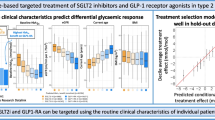Abstract
Aims
The established risk factors for severe sulfonylurea-induced hypoglycemia (SH) include low hemoglobin (Hb)A1c, advanced age, long duration of diabetes, multimorbidity, and polypharmacy. As the genetically polymorphic cytochrome P450 (CYP), enzyme CYP2C9 is mainly responsible for the hepatic metabolism of sulfonylureas (SUs), we hypothesized that the slow-metabolizer genotypes *2/*2, *2/*3, and *3/*3 might be overrepresented in type 2 diabetic patients with SH.
Methods
In a prospective population-based case-control study, CYP2C9 allelic variants of 102 diabetic patients with SH were compared with a matched group of 101 SU-treated patients without a history of SH. The 203 Caucasian patients had been treated with the SUs glimepiride, glibenclamide, or gliquidone. SH was defined as a symptomatic event requiring treatment with intravenously administered glucose and was confirmed by a blood glucose measurement of <50 mg/dl (<2.8 mmol/l). As two control groups, we selected 337 Caucasian diabetic patients receiving antidiabetic drugs per os and 1,988 healthy Caucasian volunteers who had been genotyped earlier.
Results
In the univariate analysis, only a low HbA1c value (p = 0.0004) was shown as a risk factor for SH. There was no overrepresentation of the CYP2C9 *2/*2, *2/*3, and *3/*3 variants in the SH group (2%) compared with the control group (5%). However, in the control group, patients with CYP2C9 genotypes, predicting slower metabolism of SU drugs, were treated with significantly lower doses (p = 0.027) than were extensive metabolizers, whereas in the patient group with severe hypoglycemia, the dose was the same for all genotype groups.
Conclusions
In the present cohort of 102 patients with SH, a low HbA1c value was related to the risk for SH. There was no overrepresentation observed of the CYP2C9 slow-metabolizer genotypes in the hypoglycemic patients group, but the drug exposure in the slow-metabolizer genotypes was estimated to be higher in hypoglycemic patients, which might partly have contributed to their risk for SH.
Similar content being viewed by others
References
Duckworth W, Abraira C, Moritz T et al (2009) Glucose control and vascular complications in veterans with type 2 diabetes. N Engl J Med 360:129–139
Action to Control Cardiovascular Risk in Diabetes Study Group, Gerstein HC, Miller ME et al (2008) Effects of intensive glucose lowering in type 2 diabetes. N Engl J Med 358:2545–2559
ADVANCE Collaborative Group, Patel A, MacMahon S et al (2008) Intensive blood glucose control and vascular outcomes in patients with type 2 diabetes. N Engl J Med 358:2560–2572
Currie CJ, Peters JR, Tynan A et al (2010) Survival as a function of HbA(1c) in people with type 2 diabetes: a retrospective cohort study. Lancet 375:481–489
Amiel SA, Dixon T, Mann R et al (2008) Hypoglycaemia in type 2 diabetes. Diab Med 25:245–254
Holstein A, Hammer C, Hahn M et al (2010) Severe sulphonylurea-induced hypoglycaemia - a problem of uncritical prescription and deficiencies of diabetes care in geriatric patients. Expert Opin Drug Saf 9:675–681
Kirchheiner J, Bauer S, Meineke I et al (2002) Impact of CYP2C9 and CYP2C19 polymorphisms on tolbutamide kinetics and on the insulin and glucose response in healthy volunteers. Pharmacogenetics 12:101–109
Kirchheiner J, Brockmöller J, Meiniki L et al (2002) Impact of CYP2C9 amino acid polymorphisms on glyburide kinetics and on the insulin and glucose response in healthy volunteers. Clin Pharmacol Ther 71:286–296
Niemi M, Cascorbi I, Timm R et al (2002) Glyburide and glimepiride pharmacokinetics in subjects with different CYP2C9 genotypes. Clin Pharmacol Ther 72:326–332
Becker ML, Visser LE, Trienekens PH et al (2008) Cytochrome P450 2 C9 *2 and *3 polymorphisms and the dose and effect of sulfonylurea in type II diabetes mellitus. Clin Pharmacol Ther 83:288–292
Ragia G, Petridis I, Tavridou A et al (2009) Presence of CYP2C9*3 allele increases risk for hypoglycaemia in Type 2 diabetic patients treated with sulfonylureas. Pharmacogenomics 10:1781–1787
Holstein A, Plaschke A, Ptak M, Egberts EH, El-Din J, Brockmöller J, Kirchheiner J (2005) Association between CYP2C9 slow metabolizer genotypes and severe hypoglycaemia on medication with sulphonylurea hypoglycaemic agents. Br J Clin Pharmacol 60:103–106
Holstein A, Plaschke A, Vogel M-Y et al (2003) Prehospital management of diabetic emergencies – a population-based intervention study. Acta Anaesthesiol Scand 47:610–615
Cockroft DW, Gault MH (1976) Prediction of creatinine clearance from serum creatinine. Nephron 16:31–41
Wang R, Chen K, Wen SY et al (2005) Pharmacokinetics of glimepiride and cytochrome P450 2 C9 genetic polymorphisms. Clin Pharmacol Ther 78:90–92
Suzuki K, Yanagawa T, Shibasaki T et al (2006) Effect of CYP2C9 genetic polymorphisms on the efficacy and pharmacokinetics of glimepiride in subjects with type 2 diabetes. Diab Res Clin Pract 72:148–154
Zhou K, Donnelly N, Burch L et al (2010) Loss of function CYP2C9 variants improve therapeutic response to sulfonylureas in type 2 diabetes: a Go-DARTS study. Clin Pharmacol Ther 87:52–56
American Diabetes Association (ADA) Workgroup on Hypoglycaemia (2005) Defining and reporting hypoglycaemia in diabetes. Diab Care 28:1245–1249
Leese GP, Wang J, Broomhall J et al (2003) Frequency of severe hypoglycemia requiring emergency treatment in type 1 and type 2 diabetes. Diab Care 26:1176–1180
Asplund K, Wiholm B-E, Lithner F (1983) Glibenclamide-associated hypoglycaemia: a report on 57 cases. Diabetologia 24:412–417
Greco D, Oisciotta M, Gambina F et al (2010) Severe hypoglycaemia leading to hospital admission in type 2 diabetic patients aged 80 years or older. Exp Clin Endocrinol Diab 118:215–219
Holstein A, Hahn M, Stumvoll M et al (2009) The E23K variant of KCNJ11 and the risk for severe sulfonylurea-induced hypoglycemia in patients with type 2 diabetes. Horm Metab Res 41:387–390
Acknowledgements
Data for this study were obtained within the framework of Michael Hahn’s and Olaf Patzer’s dissertations.
Author information
Authors and Affiliations
Corresponding author
Rights and permissions
About this article
Cite this article
Holstein, A., Hahn, M., Patzer, O. et al. Impact of clinical factors and CYP2C9 variants for the risk of severe sulfonylurea-induced hypoglycemia. Eur J Clin Pharmacol 67, 471–476 (2011). https://doi.org/10.1007/s00228-010-0976-1
Received:
Accepted:
Published:
Issue Date:
DOI: https://doi.org/10.1007/s00228-010-0976-1




